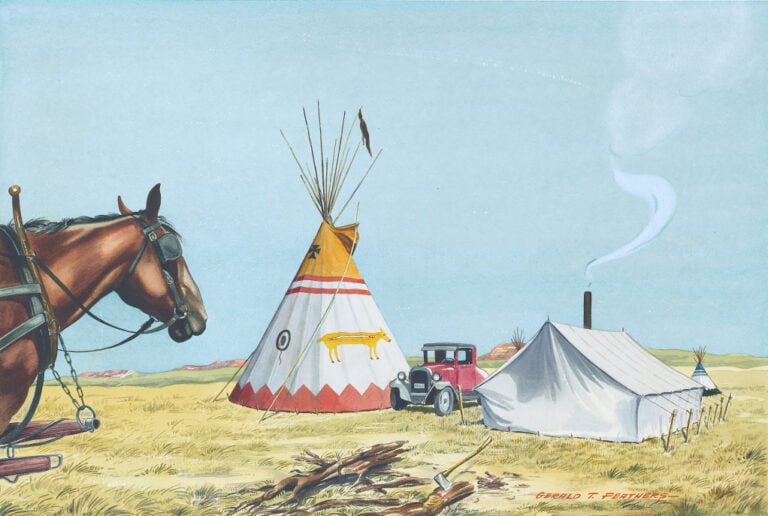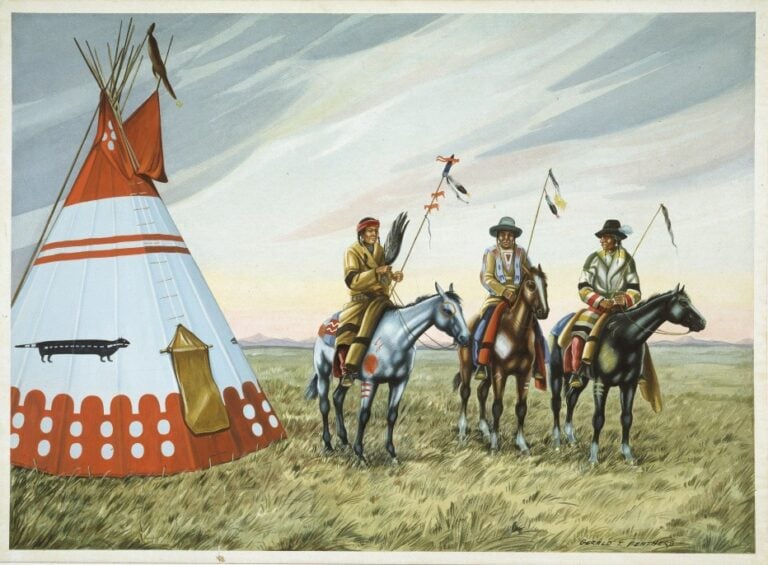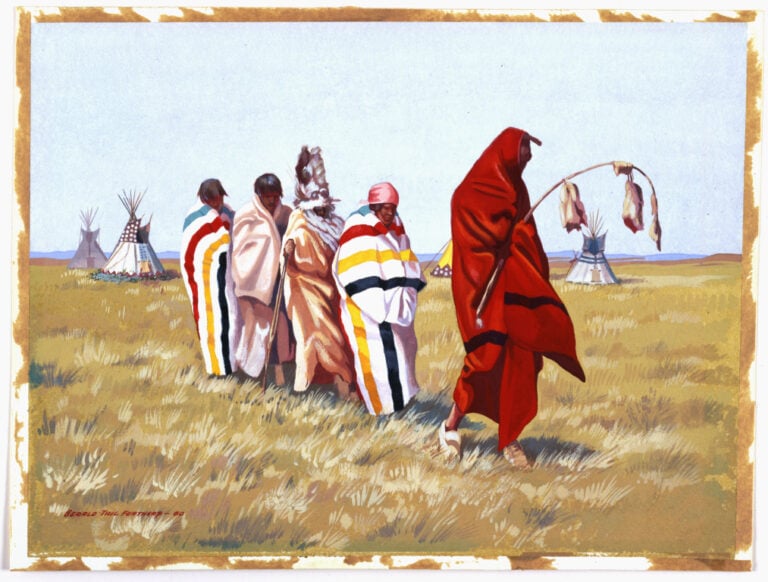This summer, Glenbow was thrilled to launch the JR Shaw Institute for Art in Canada Internship Program. Funded through a generous gift from Shaw Family Foundation, this initiative was established to give students opportunities to work with Glenbow. In this collections feature, intern Kalle Little Bear writes about her research on the artist Gerald Tail Feathers.
When I first started my JR Shaw Institute for Art in Canada Internship, I knew a research project was part of the program – but had no idea it would lead me to an interest in and connection to Gerald Tail Feathers (1925-1975). I heard of him before and knew he was an accomplished artist, but I didn’t know his life story or that he was one of the first Indigenous people in Western Canada to attend and graduate from art school and pursue art as a career.
For many Indigenous people, there is a strong sense of pride in who we are and where we come from. It’s common upon meeting another Indigenous person to ask where they’re from or who their family is. Among the Blackfoot tribes, there is often pride in being from a particular place, whether Kainai, Siksika, Piikani, or Amskapipikuni. Through Tail Feathers’ paintings you can see not only the pride he took in his work, but also his dedication to showing his people how to honour those who came before us and the reasons we are here today.

Born on the Blood Reserve in 1925, Tail Feathers attended the St. Paul’s Anglican Residential School. He showed an early interest in art and was inspired by his uncle Percy Plainswoman, a self-taught artist who signed his work by his Blackfoot name, Two Guns. He also had the support and encouragement of his mother, Ethel.
On a visit to Glacier National Park in Montana, Tail Feathers’ work caught the eye of Winold Reiss, a German artist based in New York who was known for his portraits of Indigenous people. In the summer of 1935, a group of Kainai members were invited to Saint Mary’s Lake in Glacier National Park to model for Reiss. Reiss then mentored Tail Feathers for three summers at the Saint Mary’s Lake Summer Art School. There, at 12 years old, Tail Feathers sold his first painting for five dollars.
After his time at Saint Mary’s Lake Summer Art School, a teacher submitted Tail Feathers for a scholarship to the Banff School of Fine Arts (now the Banff Centre for Arts and Creativity). A pastel sketch of Chief Shot Both Sides, the last hereditary Chief and first elected Chief of the Blood Reserve, won him that scholarship and gave him the opportunity to attend the Banff School of Fine Arts when he was 16.

Tail Feathers was taught by well-known artists at the Banff School of Fine Arts including Charles Comfort, Walter J. Phillips, and H.G. Glyde. Though he previously worked with charcoal, pastels, and watercolour, Tail Feathers felt his paintings were muddy and not properly executed. Phillips, known for his woodcuts and watercolours, taught Tail Feathers to master watercolour.
After training at the Banff School of Fine Arts, Tail Feathers moved to Calgary to study at the Provincial Institute of Technology and Art (now the Alberta University of the Arts and the Southern Alberta Institute of Technology). During his time there, his scholarship paid only for tuition and minimal living expenses. To support himself, he created and sold hundreds of Christmas cards at 25 cents each – a practice he continued for years, though eventually at a higher price.
Tail Feathers graduated in 1946 at 21 years old. After graduating, he sought a permit to work in a store display department but was denied by the government, which suggested he take on manual labour jobs. John Laurie – a teacher, advocate for First Nations rights, and friend of Tail Feathers – helped Tail Feathers get the permit he needed. In recognition of Laurie’s support, advocacy, and friendship, Tail Feathers later named his only son after him.
Tail Feathers spent many years in Calgary to take advantage of artistic opportunities. He worked as a draftsman and with the Hudson’s Bay Company as a commercial graphic artist. In his free time, he worked on his art.
Tail Feathers painted historical scenes to show who his people were and the history his Elders taught him. He wanted to create historically accurate representations of life on the Blood Reserve – a place he spent significant time away from but still loved deeply.
Tail Feathers developed a recognizable style of watercolour painting that emphasized vibrant colours. He became busy with art commissions and exhibiting his work across North America, and in the late 1950s and early 1960s, several of his artworks were acquired by Glenbow.
Before the 1960s, Tail Feathers signed his works with “Gerald T. Fethers” or “Gerald Fethers” to Anglicize his name as it was considered a disadvantage to be an Indigenous artist. His later works are signed with his full name – usually in bright red paint. Because his signature in his late paintings reads as “Tailfeathers,” many people wrote his name that way, instead of as “Gerald Tail Feathers.”

In 1959, after 14 years between Calgary, Edmonton, and Okotoks, Tail Feathers and his family moved back home to the Blood Reserve, where he opened a gas station. There, he continued to paint and developed a new skill in sculpting. He produced many clay sculptures that were bronze cast, mostly of western themes. Many of his sculptures were sold to the Calgary Stampede to be gifted to winners of the rodeo.
Tail Feathers passed away in 1975 at age 50. His life was filled with success, but also uphill battles, as being the first at anything doesn’t come without hardships. However, he had amazing support around him – a reminder of the importance of community.
Tail Feathers had great pride in where he came from. One reason I felt a connection to him is we are both from Kainai – a place I’m proud to be from and proud of the people before me. If not for the strong, resilient people who came before me, there would be no future as an Indigenous person. This is why I want to share my research on Tail Feathers’ life with others. Tail Feathers would have been 100 this year, and I hope we continue to talk about him and celebrate his major contributions to the art world as an Indigenous artist.
